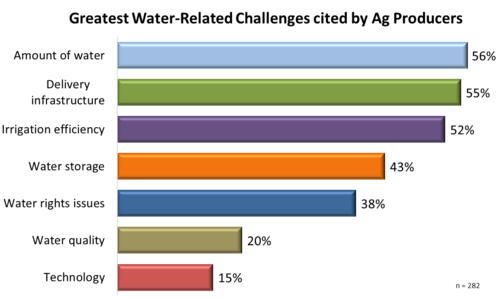Engaging Producers on Watershed Management Planning
DENVER, Colo. - The Colorado Water Plan includes twin goals of having 80 percent of the state’s critical watersheds covered by watershed management plans and 80 percent of the locally prioritized streams covered by stream management plans by 2030. Successful watershed and stream management planning involves people representing all local water interests, and that nearly always includes the agricultural community. Through ownership and leasing, agricultural producers control most of the water and land in Colorado. Agricultural input and cooperation is essential to achieving needed improvements in our streams and watersheds.
Irrigation water is a vital component of Colorado’s agricultural industry. Without it, crop and forage yields are dramatically lower. Colorado agricultural statistics indicate that an irrigated field of corn, for example, will produce almost three times more grain than a non-irrigated field of corn. Irrigation water is a big part of the reason Colorado agriculture contributes $41 billion to our state’s economy.
We often say that agriculture provides food, fiber and fuel, but Colorado agriculture accomplishes much more. It preserves open space and extraordinary vistas, provides wildlife habitat - including habitat for threatened and endangered species – and connects us with our agricultural heritage, helping to create a sense of place and community. Consider the farmer’s markets and Colorado-made foods and beverages we enjoy. Much of it would not be possible without irrigation water.

Agricultural producers want to engage on local water-related planning activities. Colorado Cattlemen’s Ag Water NetWORK’s 2019 state-wide survey of agricultural producers found almost one-fourth of respondents were “very interested” in participating (see chart). Eighty-eight percent of respondents said were at least “somewhat interested” in getting involved in local watershed management planning efforts.
Like other stakeholders, agricultural producers have specific interests around water. Farmers need to utilize their water rights to grow crops and forage and to water livestock. For surface water users this means diverting water from rivers and streams and other surface water bodies and conveying it to fields for application.
The top three (3) water-related challenges expressed by survey respondents were all irrigation-related (see chart below). Note that the survey allowed producers to select more than one challenge, so the percentages exceed 100 percent when totaled. Not having enough water (“amount of water”) was closely followed by water delivery infrastructure. These two challenges along with “water storage” - which was the fourth most frequently cited challenge - are often interrelated and addressing them can be capital intensive. Demand for grant and cost-share funding chronically exceeds available financial resources.

Through the watershed and/or stream management planning process, funding for irrigation water diversion and delivery infrastructure and source water protection can be obtained from a wider range of sources than is typically available to agriculture as long as projects are multi-benefit in nature. One example is the combination of stream channel and embankment improvements with a diversion dam replacement – which may also incorporate a fish passage that allows aquatic life to move past the diversion structure. Projects like these help wildlife, aquatic life, water quality and irrigators alike. Because this type of project benefits multiple uses, it can garner more funding and reduce the cost to irrigators.
The third greatest challenge cited by ag producers was irrigation efficiency. One of the benefits of watershed and stream management planning is that the process involves assessment and analysis of prioritized problems.This helps to ensure that solutions fix existing problems without creating unintended negative consequences. For example, how should individual farmers and ranchers best address irrigation ditch seepage and irrigation efficiency?
Increasing irrigation efficiency – like switching from flood irrigation to sprinkler – can reduce or even eliminate deep percolation of water as well as runoff from the edge of the field. Lining earthen ditches with concrete improves the delivery of water to fields by eliminating seepage. This can also improve water quality in streams by reducing the selenium and salinity content of seep water in areas where shale is near the surface.
However, leaky irrigation ditches also provide watering spots and seasonal wetlands – serving as an oasis for wildlife and birds in otherwise dry areas. Also, flood and furrow irrigated fields and meadows release water slowly back to streams and rivers later in the summer and fall, enhancing flows after snowmelt and summer rains have dwindled. This supplemental flow helps sustain fish and wildlife, and extends recreational use in some cases. So, a thorough evaluation of a canal or ditch system is crucial to understanding how to help agricultural producers and other stakeholders achieve multi-benefit solutions.
The ultimate goal of watershed and stream management planning is to implement actions that benefit watersheds and streams, as well as the stakeholders that use and rely upon them. Engaging agricultural producers and getting to know them and their water-related challenges will help achieve outcomes that benefit all stakeholders.
|